


Framed or unframed, desk size to sofa size, printed by us in Arizona and Alabama since 2007. Explore now.
Shorpy is funded by you. Patreon contributors get an ad-free experience.
Learn more.

- Baldwin 62303
- Baldwin VO-1000
- Cold
- No expense spared
- Tough Guys
- Lost in Toyland
- And without gloves
- If I were a blindfolded time traveler
- Smoke Consumer Also Cooks
- Oh that stove!
- Possibly still there?
- What?!?
- $100 Reward
- Freeze Frame
- Texas Flyer wanted
- Just a Year Too Soon
- WWII -- Replacing men with women at the railroad crossing.
- Yes, Icing
- You kids drive me nuts!
- NOT An Easy Job
- I wonder
- Just add window boxes
- Icing Platform?
- Indiana Harbor Belt abides
- Freezing haze
- Corrections (for those who care)
- C&NW at Nelson
- Fallen Flags
- A dangerous job made worse
- Water Stop
Print Emporium
Skyscraper: 1909
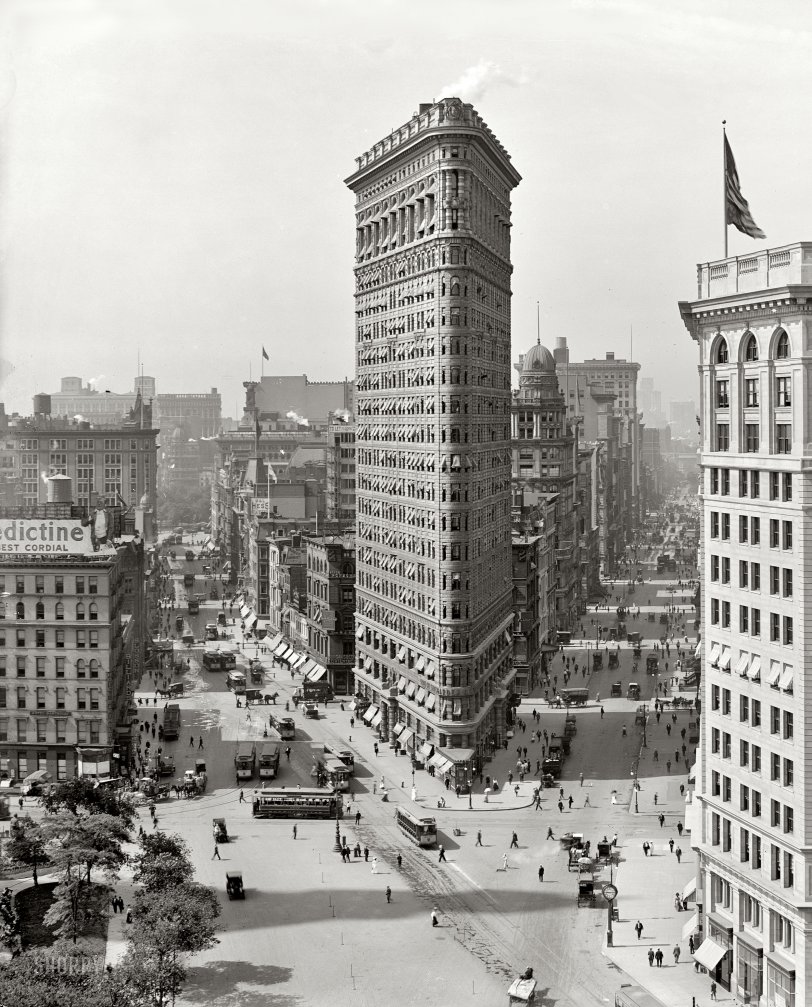
New York circa 1909. "Panorama of Madison Square." This glass plate, part of a nine-exposure panorama, affords yet another view of that enduring architectural icon, the Flatiron Building. 8x10 dry-plate glass negative. View full size.
Re: S.S. Flatiron and American Parthenon
Something as glorious as this had to appear sooner or later.
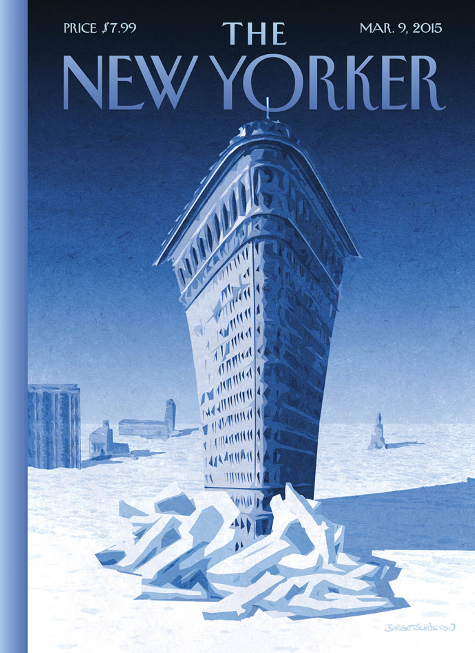
Pach Brothers Studio
If you look close at the building behind the Flatiron you can see a billboard (on the roof) for Pach Brothers Studio. I took portrait classes from the last owner of Pach Brothers, Oscar White. When he closed the studio it was the oldest operating studio in North America. He had an amazing archive of famous clients' images. President Ulysses S. Grant was involved in getting the studio started.
The clock
Who maintained it?
I know there were lamplighters during the times when gas lamps lit city streets, but the clock must have been mechanical. Did someone wind it, or were they electric even back then?
Omnibus
Ok, I'm the first to spot the motorized bus! It looks more like someone chopped the back off a 1920s bus and shoved an open cab on the front with an engine. Neat! Also, notice the peculiar way of routing with a lampstand in the middle of the open street and ropes and posts in a line from it.
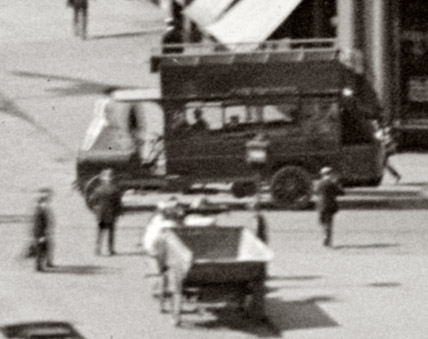
The streets are full of streetcars, too!
Including the blurry end of one on the extreme left, and off into the distance, I count no less than 20 streetcars. Is it 1912 rush hour?
Google Clock View
White Wing
The Department of Sanitation's "White Wing" sweepers did their level best keeping those NYC streets clean. I don't know if white was the best color for their uniforms though!
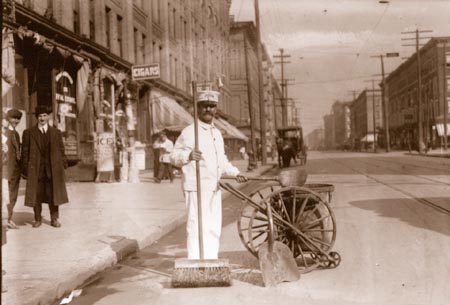
Entrances
Comparing this picture with StreetView, the building entrances in the middle of each side seem to have been remodelled. Instead of the pillars supporting the canopy being proud of the main building, they are now just a relief on the surface.
Hotel Bartholdi
I am fascinated to find that this is the location of the Hotel Bartholdi. A few weeks ago I posted an image in the members gallery, of an electric charabanc parked, I assume, in front of the hotel.
The streets are full of people
That's something you don't see these days. People are afraid of speeding cars. I assume that horse-drawn carriages weren't quite as dangerous.
From 1 to 9, slowly.
If I look at the panorama too quickly, I may get dizzy.
6 E. 23rd
The FDNY suffered its largest loss prior to 9/11 on the site of the Bartholdi Hotel. On October 17, 1966 a fire spread from an adjoining property on 22nd street to the basement of 6 East 23rd street. Twelve firefighters were lost that night when the floor of the Wonder Drug Store collapsed.
Sprint
Last time I was there in 2005, Sprint occupied the first floor of the Flatiron Building. Kind of sacrilege, really.
Manure guy
In the foreground, white uniform, big shovel.
M&L Hess Real Estate
Sign was still somewhat visible as of 2003.
98 Years Ago
In the great span of history, 98 years isn't really all that long, and the march of history in centuries past wasn't all that brisk. But here we have a 1912 street scene from midtown Manhattan, less than a century ago (almost), within living memory of at least a few souls still among us, and the horses still outnumber the motor vehicles. I'm guessing that in another five years, by 1917 or so, the cars would outnumber the horses, and that in 10 more years -- 1927 or so -- the number of horses would be very small indeed. This is really a glimpse at the very last days of the pre-automobile world. We haven't lived with these infernal, gas-guzzling contraptions for very long.
American Parthenon
Alfred Stieglitz also saw the Flatiron as a kind of steamship: "With the trees of Madison Square covered with fresh snow, the Flat Iron impressed me as never before. It appeared to be moving toward me like the bow of a monster ocean steamer, a picture of new America still in the making. The Flat Iron is to the United States what the Parthenon was to Greece."
Awnings again
The main advantage of awnings (as opposed to, say, shades or venetian blinds) was that they let you keep the window open in the rain. Open windows were necessary probably as much for ventilation as keeping cool.
[Although they do seem more prevalent on the sunny side of the building. - Dave]
Awnings were a necessity
This was long before air conditioning was prevalent so awnings were a common method used to cool down a building while still maintaining the view out the window.
23 Skidoo
Legend has it that the unique winds created at this intersection (Fifth and Broadway at 23rd Street) would lift many a lady's skirt, much to the delight of the male audience that would congregate here (at least when women still wore dresses).
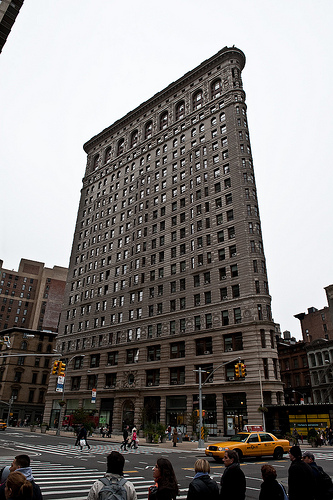
Look at the Time
The first thing that stuck out to me was the standing clock, which is very recognizable. It still stands there today. Also interesting is that that 200 Fifth Avenue, or International Toy Building (to the right of the Flatiron, next to the clock), was just built in 1912. It recently underwent an interior overhaul.
Ahhh summer!
I am sure that the awning helped to keep the stores and offices cool in the summer. All the open windows (at least even one with a curtain blowing in the breeze) in skyscrapers! How odd to today's eyes of closed up buildings.
That sign selling cordial sure gave me a start.
1 of 9
Please don't leave us hanging; we want to see all 9 negatives!
As always, thanks for this.
And I wouldn't describe it as an awning obsession, more like a necessity on those hot New York August afternoons.
Deja Vu All Over Again
We return to Madison Square Park (bottom left) and the back of the statue of William H. Seward, he of the folly. Also we see the Hotel Bartholdi, named after the Statue of Liberty sculptor. The corner storefront of the Flatiron Building appears to contain our old friend the United Cigar Store. On the next block, East 22nd Street, the corner is occupied by the VanGaasbeek Oriental whatever. That corner now houses a usually deserted Restoration Hardware, which appears to be in the original building that we see in the photo.
S.S. Flatiron
With that puffy plume at the top, it looks like it's steaming up Broadway.
Awful Awnings
Beautiful building, but the aesthetic is somewhat spoiled by the awning obsession of the era.
























On Shorpy:
Today’s Top 5